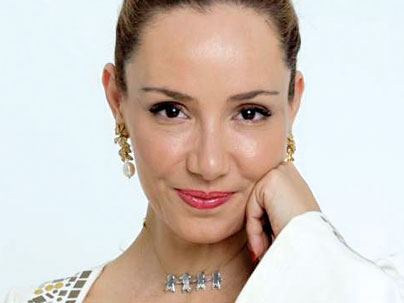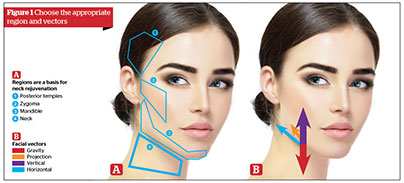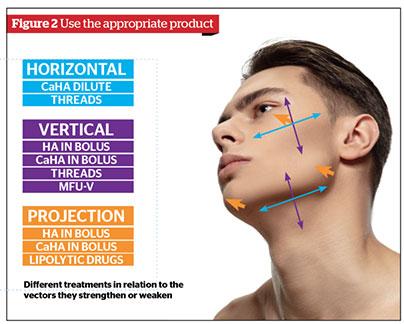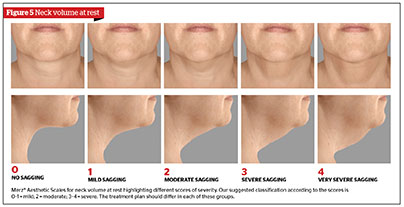STEP 1 - Choose regions to treat (the more severe the case, the more regions involved). Consider the anatomy in order to understand the impact each region will have on the rest - e.g., treatment of the zygoma area has a great impact on the mandible area, and, after treatment of the posterior temples we see a great impact in the lateral face; zygoma and mandible regions will therefore impact in the upper neck.
STEP 2 - Choose vectors; during the ageing process we experience the loss of bone, fat, and skin thickness, each of which have a different impact in the vectors against gravity, and so each region of the face has more important vectors to treat. For lower face and neck rejuvenation, the vertical and horizontal vectors are more important than the projection. (FIG 2) Specifically for the neck, the vertical vector means either to enhance the vertical height of the mandible or to shorten structures such as the SMAS (Platysma + fascia) from mandible to clavicle, and horizontal vectors - to create some shortening in the direction of the back the neck by strengthening the SMAS - skin connection or creating skin retraction. The only projection vector that can affect the neck is the width enhancement of the chin or masseter, but those can be only performed in few individuals with that kind of need.
STEP 3 - Identify the problematic layer: bone, fat, muscle, fascia or skin.
STEP 4 - Choose treatment according to the vectors: every procedure we do strengthens or weakens a different vector against gravity. E.g., if we inject a bolus of HA (Hyaluronic Acid) in the zygoma area we strengthen the projection effect, whereas if you inject CaHA dilute in lateral face, you strengthen the horizontal vector of the face. Or, if you inject the same HA in lower border of mandible, we strengthen the vertical vector. (Figure 3,4)
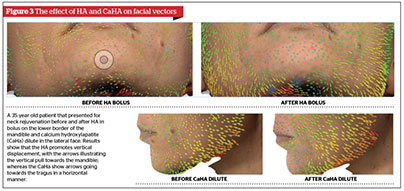
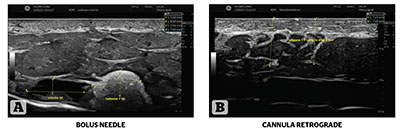
Figure 4 (A) was taken during injection of a patient for projection of zygoma with CaHA in bolus on the bone.
Figure 4 (B) was taken during injection of CaHA dilute in subdermal plane for biostimulation.
STEP 5 - Choose the layer to treat according to best use of the products. Sometimes one product has a better projection capacity if used in the supraperiosteal area instead of in the subdermal area. The use of a bolus rather than retrograde injections have a better projection capacity. (Figure 4)
STEP 6 - Choose the amount of product to use depending on the severity (Figure 5).
STEP 7 - Choose a maintenance plan depending on the severity (Figure 5).
After the step-by-step approach for treatment, the next step is to follow-up with our patients through their journey and to monitor results, but also to follow up in the short term to prevent any possible complications. Depending on the procedure there is a specific time that should be respected for immediate and long term follow up, for example: filler injected should be followed up the next day to check for any lumps, pain, bruising or discoloration, to guarantee there is no complications. For toxin injection follow up occurs around day 15 as this is when any major complications can present, such as ptosis, asymmetries and lack of result.
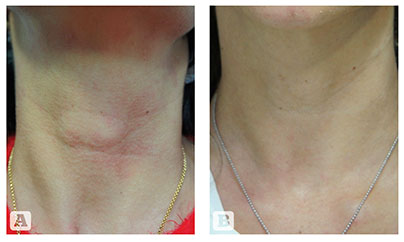
Figure 6 (A) Before and (B) after 1 year of combination treatment: Ulthera®(Merz Aesthetics, Germany), Radiesse® (Merz Aesthetics, Germany) dilute 1:1 and Belotero Soft® (Merz Aesthetics, Germany) taking place on the same day.
When severity differs, different goals and different layers are involved and so patients will be given contrasting treatment plans and combinations of treatments. This illustrates very well how complicated the decisions for neck rejuvenation can be.
The conclusion from these studies show that is that is vital to be systematic not only in the evaluation of neck aging, but also when electing procedures and the specifics for each patient; each decision makes a difference to the amount of product required and time needed to achieve optimal, desired results.
REFERENCES:
- Cohen JL, Rivkin A, Dayan S, Shamban A, Werschler WP, Teller CF, Kaminer MS, Sykes JM, Weinkle SH, Garcia JK. Multimodal Facial Aesthetic Treatment on the Appearance of Aging, Social Confidence, and Psychological Well-being: HARMONY Study. Aesthet Surg J. 2022 Jan 12;42(2):NP115-NP124. doi: 10.1093/asj/sjab114. PMID: 33751048; PMCID: PMC8756087.
- Friedman O, Shamban A, Fabi S, Duncan DI, Artzi O. The Aging neck-A Case base treatment algorithm. J Cosmet Dermatol. 2021 Feb;20(2):569-576. doi: 10.1111/jocd.13877. Epub Dec 19. PMID: 33340202
- Casabona G, Kaye K. Facial Skin Tightening With Microfocused Ultrasound and Dermal Fillers: Considerations for Patient Selection and Outcomes. J Drugs Dermatol. 2019 Nov 1;18(11):1075-1082. PMID: 31738490.
- Pérez P, Hohman MH. Neck Rejuvenation. 2022 Feb 27. In: StatPearls [Internet]. Treasure Island (FL): StatPearls Publishing; 2022 Jan–. PMID: 32965900.
- Casabona G, Frank K, Koban KC, Schenck TL, Lopez VP, Webb KL, Hamade H, Freytag DL, Green JB, Cotofana S. Influence of Age, Sex, and Body Mass Index on the Depth of the Superficial Fascia in the Face and Neck. Dermatol Surg. 2019 Nov;45(11):1365-1373. doi: 10.1097/DSS.0000000000001909. PMID: 30882511.
- Kwon SH, Ahn GY, Lew BL, Shin JW, Na JI, Huh CH. Clinical Implication of the Regional Thickness of the Lower Facial Skin, Superficial Fat, and Superficial Musculoaponeurotic System on High-Intensity Focused Ultrasound Treatment. Dermatol Surg. 2022 May 1;48(5):527-531. doi: 10.1097/DSS.0000000000003393. Epub 2022 Jan 26. PMID: 35093961.
- Casabona G, Frank K, Koban KC, Freytag DL, Schenck TL, Lachman N, Green JB, Toni S, Rudolph C, Cotofana S. Lifting vs volumizing-The difference in facial minimally invasive procedures when respecting the line of ligaments. J Cosmet Dermatol. 2019 Aug 12. doi: 10.1111/jocd.13089. Epub ahead of print. PMID: 31402563.
- Casabona G, Frank K, Moellhoff N, Gavril DL, Swift A, Freytag DL, Kaiser A, Green JB, Nikolis A, Cotofana S. Full-face effects of temporal volumizing and temporal lifting techniques. J Cosmet Dermatol. Nov;19(11):2830-2837. doi: 10.1111/jocd.13728. Epub Oct 5. PMID: 32946624.
- Vanaman Wilson MJ, Jones IT, Butterwick K, Fabi SG. Role of Nonsurgical Chin Augmentation in Full Face Rejuvenation: A Review and Our Experience. Dermatol Surg. 2018 Jul;44(7):985-993. doi: 10.1097/DSS.0000000000001461. PMID: 29309340.
- Truswell WH. Complications in Lower Face Rejuvenation: Avoiding, Minimizing, Recognizing, Dealing with Them, and Helping the Patient through the Process of Fixing the Problems. Facial Plast Surg. Aug;36(4):462-477. doi: 10.1055/s-0040-1713823. Epub Aug 31. PMID: 32866983.
- Gentile RD. Renuvion RF-Helium Plasma for Subdermal Skin Tightening, Facial Contouring and Skin Rejuvenation of the Face and Neck. Facial Plast Surg Aesthet Med. Jul/Aug;22(4):304-306. doi: 10.1089/fpsam..0070. Epub May 5. PMID: 32379988; PMCID: PMC7374633
